
The first and foremost
mission on our second and last full day in Rome was to see the Sistine
Chapel.  This
was within the huge Vatican Museum complex. So after another wild cab
ride, we were back at the Vatican, getting in "line." It turned
out to be a 10-foot-wide, many-blocks-long mass of tourists, tour groups,
and Italians on holiday.
This
was within the huge Vatican Museum complex. So after another wild cab
ride, we were back at the Vatican, getting in "line." It turned
out to be a 10-foot-wide, many-blocks-long mass of tourists, tour groups,
and Italians on holiday.
It was two hours on the hard sidewalk, being jostled from behind every few moments by Japanese and French tourists who seemed to have no concept of personal space. We'd find out that this long wait wasn't typical and aren't sure why it was, but it probably had something to do with the long holiday weekend, Labor Day in Italy. We had to endure ... who know when or if we'd ever have this chance again?
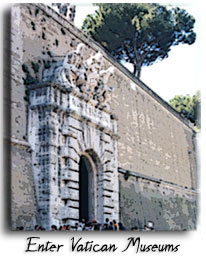 Once
in, we didn't linger in any of the many sections or courtyards. Too many
people and tired feet from the wait kept us pressing through ... onward
to the far end and the Capella Sistina. [Enter
here] It seemed to take forever to get there, but finally,
finally, we were in. I immediately took a couple photos, only to be told
"no photos" — I claim ignorance because everything else
to this point was OK to photograph. Guilt-free, I was happy that I hadn't
seen the prohibitive sign.
Once
in, we didn't linger in any of the many sections or courtyards. Too many
people and tired feet from the wait kept us pressing through ... onward
to the far end and the Capella Sistina. [Enter
here] It seemed to take forever to get there, but finally,
finally, we were in. I immediately took a couple photos, only to be told
"no photos" — I claim ignorance because everything else
to this point was OK to photograph. Guilt-free, I was happy that I hadn't
seen the prohibitive sign.
The Chapel was smaller, narrower than I'd imagined. The colors of Michelangelo's masterpieces were brilliant and beautiful after having recently been carefully cleaned of many centuries worth of grime. We were able to find a space on the periphery bench to just sit and stare, for over a half hour. How awe-inspiring was this? Michelangelo was such a master sculptor, that his figures in paint also looked to be three-dimensional, coming out from the ceiling toward us. He worked on the ceiling between 1508 and 1512, and then, years later, painted the Last Judgment on the side wall — another seven years of work completed in 1541. How this was humanly possible ... The Last Judgment is mesmerizing.
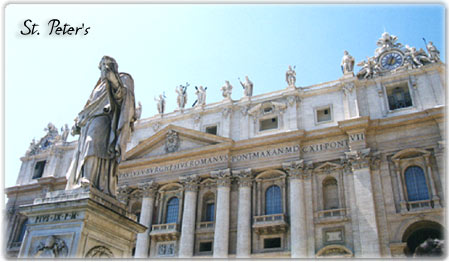 What
could possibly top that? Well, let's go in St.Peter's just outside the Chapel exit. Another awesome experience.
An ornate,
What
could possibly top that? Well, let's go in St.Peter's just outside the Chapel exit. Another awesome experience.
An ornate, ![]() overwhelming
basilica that was a collaborative effort begun in 1506 when Pope Julius
set the first stone of the new church ... many great Roman and Baroque
architects worked on this, and it took more than a century to build.
overwhelming
basilica that was a collaborative effort begun in 1506 when Pope Julius
set the first stone of the new church ... many great Roman and Baroque
architects worked on this, and it took more than a century to build.
Just inside was the Pietà — Peter & I had both seen it in 1964, over 36 years earlier, at the World's Fair in New York. It's one of my most vivid memories of the Fair, and seeing it again was special. Unfortunately, it's behind a large glass pane for protection after some lunatic tried to attack it a while back. I don't have the vocabulary to describe the sumptuousness of St.Peter's interior— I hope the pictures will convey something of the atmosphere.
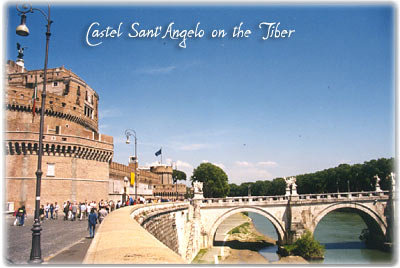 Next
up, the Castel Sant'Angelo, also within Vatican walls next to the Tiber
...I'd hoped to go inside, climb to the top and see the view, but alas,
closed Mondays. Just as well, it would turn out ...
Next
up, the Castel Sant'Angelo, also within Vatican walls next to the Tiber
...I'd hoped to go inside, climb to the top and see the view, but alas,
closed Mondays. Just as well, it would turn out ...
But the exterior was
impressive enough ... It dates from 139 AD and was originally Emperor
Hadrian's mausoleum. Over the centuries it has been many things including
a prison and a residence for popes. There is an escape route hidden somewhere
from the Vatican Palace to the Castel for the pope to use in times of
trouble. [Castel
views]
We walked along the Tiber and crossed it via Ponte Umberto, back into Rome proper. Then headed towards the Spanish Steps and Piazza Spagna, on Via Condotti, a narrow street full of ritzy shops.
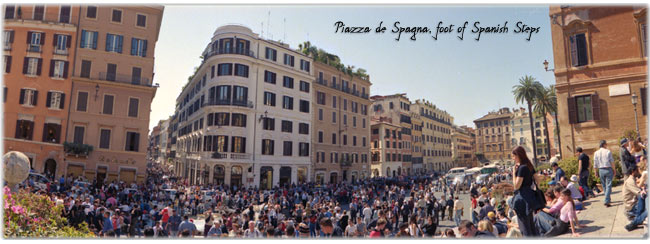
 The
Piazza and Steps were packed with people .. so many that I never even
noticed Bernini's Fontana della Barcaccia in the middle because it was
surrounded, and low to the ground. The Spanish Steps were designed to
link the Piazza to the church with elegant bell towers, Trinita
dei Monti, on the hill above. It was hot, and bright purple azaleas,
along and extending up the Steps, were still in bloom, though past peak.
I was amazed at all the people just hanging out. And here's where I ask:
how hot must it be for Italians to wear shorts? Wherever we went in Italy
we were immediately identifiable as tourists, most likely American, because
of our shorts. On this I didn't mind looking so foreign, especially if
blending in meant we'd have to sweat it out in dark pants. Must be a cultural
thing ... shorts aren't done here.
[Trinita panoramic]
The
Piazza and Steps were packed with people .. so many that I never even
noticed Bernini's Fontana della Barcaccia in the middle because it was
surrounded, and low to the ground. The Spanish Steps were designed to
link the Piazza to the church with elegant bell towers, Trinita
dei Monti, on the hill above. It was hot, and bright purple azaleas,
along and extending up the Steps, were still in bloom, though past peak.
I was amazed at all the people just hanging out. And here's where I ask:
how hot must it be for Italians to wear shorts? Wherever we went in Italy
we were immediately identifiable as tourists, most likely American, because
of our shorts. On this I didn't mind looking so foreign, especially if
blending in meant we'd have to sweat it out in dark pants. Must be a cultural
thing ... shorts aren't done here.
[Trinita panoramic]
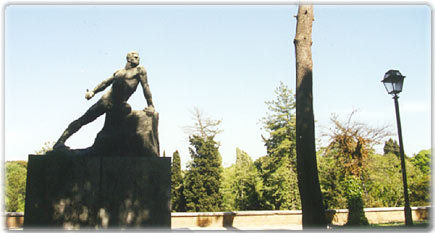 OK,
now we were ready to get a cab back to the hotel and head out in a different
direction to see Via Appia. Well. Not so fast.
OK,
now we were ready to get a cab back to the hotel and head out in a different
direction to see Via Appia. Well. Not so fast.
No cabs to be found. We climbed the Steps, and headed through the Pincio Gardens. A beautiful park full of unique, interesting sculptures ... and we continued north, in the direction of the hotel. But the park abruptly ended as it bordered on a small cliff, overlooking a busy street. Reversing direction, we descended to the Piazza del Popolo.
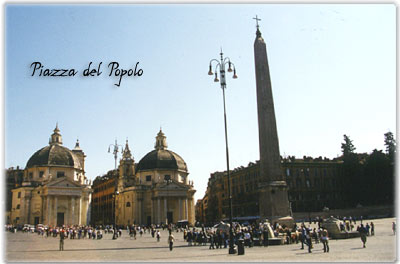 A
broad oval-shaped expanse of cobblestones, with twin churches Santa Maria
di Montesanto and Santa Maria dei Miracoli flanking one side, and an Egyptian
obelisk as exclamation point in the center. The obelisk is over 3,000
years old, and was brought to Rome by Augustus Caesar. The Santa Marias
were designed by Carlo Rainali a century later — they are so impressive;
their long porticos form the entry to Via del Corso.
A
broad oval-shaped expanse of cobblestones, with twin churches Santa Maria
di Montesanto and Santa Maria dei Miracoli flanking one side, and an Egyptian
obelisk as exclamation point in the center. The obelisk is over 3,000
years old, and was brought to Rome by Augustus Caesar. The Santa Marias
were designed by Carlo Rainali a century later — they are so impressive;
their long porticos form the entry to Via del Corso.
Across the way was a trolley stop and a bus stop. Good, we can find a ride back to the hotel ... Armed with maps, an Italian dictionary, and some form of intelligence, we surmised that none of these modes of transport were going our way. On very tired legs and feet, and with no choice, we began the long walk. Well, I did want to see Rome, up close and personal. And luckily it was a nice area to be "stuck" in — Villa Borghese park. So off we went on our mostly uphill trek back to the Parioli district and the hotel.
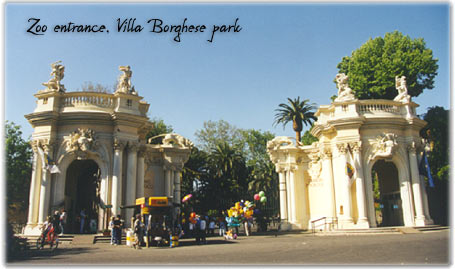
We saw many beautiful areas; and Romans do their entry ways and borders in such spectacular fashion — everything is an architectural wonder.
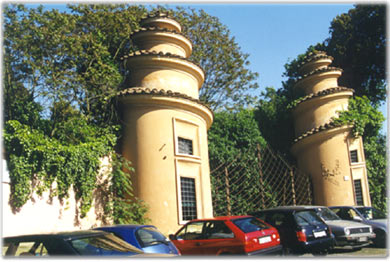
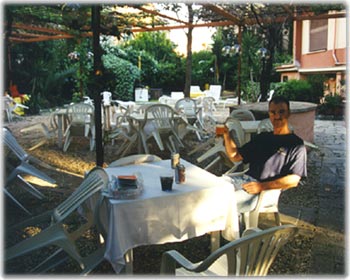 I'm
not sure how far we walked, but I felt soreness in leg muscles that I
hadn't known existed. But, more than worth it: we got a great feel for
Rome covering so much ground on foot.
I'm
not sure how far we walked, but I felt soreness in leg muscles that I
hadn't known existed. But, more than worth it: we got a great feel for
Rome covering so much ground on foot.
Here's to Rome, an incredible city; and to a return visit sometime soon. We barely scratched the surface in our two-and-a-half days, though not for lack of trying!
Back
to Italy main
Roma
• Roma2 • Roma3 • Vesuvio
& Pompei • Sorrento to Amalfi Coast
• Capri
Amalfi Coast • Perugia • Siena
& Toscana • Firenze • Firenze2
© 2001 CCarnovale Home | Web Design | Graphics | Photos | Travels